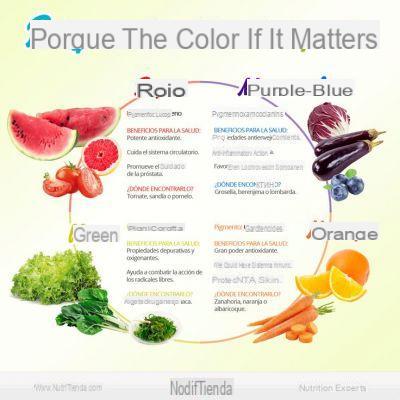
Do we eat them all these colors? Yellow, red, purple, orange, white, green ... Associating a color with what you put in your mouth can be useful to remember and understand what our body needs every day to live healthily, especially if we provide it correctly through the diet.
In fact, fruit and vegetables represent an important source of nutrition: both bring considerable benefits, including vitamins, minerals and more. Learning to bring them to the table based on color becomes even fun!
There are bioactive substances, named compounds of vegetable origin in fruit and vegetables fitochimici. Some of them are particularly interesting because, in addition to having certain nutritional qualities, they give particular colors to foods. Let's find out what is hidden among the pulp, the leaves and under the colored peels!
Green as a force
The compounds responsible for the green color in plants are i glucosinolates. These are derivatives of amino acids containing sulfur. These compounds are known forantitumor effect and have a protective action against free radicals.
Dark green is also the color of the iron: spinach, chard, herbs contain in good quantities. They also have folic acid and vitamin C, which helps to absorb it.
Among these vegetables there are also broccoli, Roman cauliflower, Brussels sprouts, cabbage, agretti, asparagus, basil, beets, artichokes, cucumbers, chicory, turnip greens, endive, lettuce, parsley, rocket and zucchini. And among the fruit, the greenest of all is the Kiwi.
Growth is orange and yellow!
Orange rhymes with melon, but also with orange, peach, apricot, pumpkin, pepper, carrot, mango, persimmon and papaya.
The phytochemicals responsible for the orange coloring of these fruits and vegetables are i carotenoids A and B carotene. These substances are very important for the hormone synthesis, in the processes of cell differentiation and growth and in the immune response.
The flavonoids are, together with the b-cryptosanthin, another carotenoid, responsible for the light orange color tending to yellow. Notes are their properties antiviral, anti-inflammatory and antioxidant; they also prevent the oxidation of bad cholesterol and help prevent diseases such as Alzheimer's and Parkinson's.
Oranges, precious allies and the role of vitamin C
Red protects
The red color of fruits and vegetables is given by lycopene, also belonging to carotenoids, such as the a and b carotene.
It is found in tomato, in watermelon, in grapefruit. But also in peppers, beets, cherries, chicory from Chioggia, pomegranate, strawberries, red fruits, berries, currants, radishes and red salad. Color red it has remarkable antioxidant properties, plays an important role in cellular communication and there is evidence that confirms its effectiveness against prostate cancer, the cardiovascular disease and damage resulting from exposure to ultraviolet rays and smoke.
Purple not to get old
The purple color of grapes, blackberries, plums, figs, blueberries instead it is to be attributed to anthocyanins. These are substances that belong to the largest group of phenolic compounds, the flavonoids.
Anthocyanins possess remarkable antioxidant properties. Among the vegetables that have this blue, purplish color we remember the eggplant, black cabbage, radicchio.
White is multitask!
White vegetables are rich in quercetin, a antioxidant, antiallergic substance and very active in cancer prevention; these vegetables are excellent allies for health, lower cholesterol levels and strengthen bones and lungs.
There are onions, garlic and leeks, apples, pears, mushrooms and cauliflower. Garlic and leeks contain allisolfuro, which thins the blood and protects the body from thromboembolic events. The selenium, trace element present in small quantities in foods, is present in mushrooms, prevents arterial hypertension, anemia and numerous forms of cancer.
Fruit in comparison: the pros, cons and tips for choosing it
To learn more:
> Vegetables: list, properties, nutritional values


























